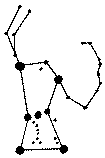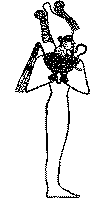and The Lost Secrets
Ancient Egyptians and the Constellations: Part 2
Who is God, the Creator? The Celestial Sphinx?
Hu is God, the Creator, the Celestial Sphinx.
The Lost Word
In the heavens the Celestial Sphinx is caught in the act of Creation. As he becomes a living God he gently expels his first breath Hhhhhhooooooo. As the first Word of God is pronounced it sounds like the harmonics of a cosmic breeze.

As a second breath is expelled Hhhhhhooooooo the sounds and name of the Ancient Egyptian god Hu Hu, meaning "Authoritative Utterance: Word of God: Word of Creation", is revealed.

"h" "h" Hu
A "hawk on a standard" is an ancient Egyptian hieroglyph for "God". The phonics of the hieroglyphs sound out the pronunciation of the pictogram of the God Hu. Technically he is called Hu Hu as it is a double utterance.
As the Celestial Sphinx continues to expel his breath of life, Hhhhhhooooooo, the heavens are progressively created. The Celestial Sphinx is the Creator and Architect of the Universe. The Celestial Sphinx is God and the ancient name for God was Hu.
"In the beginning was the Word, and the Word was with God, and the Word was God." (John 1 v 1,2)
* In the beginning was the Word, Hhhhhhooooooo,
* and the Word was with God, who was the Celestial Sphinx named Hu by the remote Ancient Egyptians,
* and the Word was God. Hhhhhhooooooo.
Clearly "Hhhhhhooooo" or "Hu" is the Word or utterance which means "God".
The Lost Secrets
The earthly representation of the Celestial Sphinx can still be seen today to the east of the Pyramids at Giza. The word "Sphinx" is of Ancient Greek origin meaning "an enigma" or "a riddle", because to the Ancient Greeks the purpose of the Sphinx was obscure, its meaning had been lost.
To the remote Ancient Egyptians however the esoteric meaning and purpose of the Sphinx at the Giza Plateau was abundantly clear: as demonstrated by their name for the Sphinx … Hu.
Imagine the scene at the Dawn of the Egyptian Civilization. A ceremony in which the Creation of the Universe is re-enacted is in progress. Night is falling. The image of the Giza Sphinx, Hu, sits waiting. There is absolute silence. The Act of Creation has not yet begun. Finally, at a given signal the air vibrates with the sound of the First Word of Creation, Hhhhhhooooooo. The Word of God is chanted throughout the night and the following Dawn until the process of the Creation of the Universe is complete. The final Act of Creation is the Sun when it rises in the East.
The first and final Words of God were identical, Hhhhhhooooooo. With the First Word God created Orion, the soul of Osiris. With the Last Word God created the Sun. The whole process of Creation is contained within the name Hu Hu … the First and the Last Breaths of the Creator.
The first shall be last and the last shall be first. (Mark 10 v31)
The body of the remote Ancient Egyptian God of Creation, Hu, was deliberately leonine, as the superbly crafted lion was a symbol of Power and Strength. The lion was omnipotent. Even today the lion is referred to as "King of the Beasts". The face of the Creator with the distinctive Osiris Beard, and the Red Crown of the Creator, are the hallmarks of the remote Ancient Egyptians.
The remote Ancient Egyptians must have thought it uncanny when they first stumbled across the outcrop of rock, which so resembled the general shape of the Celestial Sphinx, on the Giza Plateau. However, even more startling was the fact that it lay in a perfect East / West alignment. By carving out the Sphinx, Hu, facing towards the East, the Creator was able to daily observe his final Act of Creation, the Sun, rising above the horizon.
Imagine the Giza Plateau at Dawn, 6:59am on March 19th 14000BCE. (Working back in Time using the Gregorian Calendar.) The Celestial Sphinx, Hu, is sitting on the horizon watching the birth of his final Act of Creation, the Sun. It is sunrise on what would seem to be the first perfect day.
However there is one imperfection: the Sun is not rising exactly in the East. Rather it is rising in the ESE. Sunset is not an exact twelve hours later. It is at 5:13pm.

The celestial Sphinx, Hu, is sitting on the horizon viewing
Dawn , the Birth of his last act of Creation, the Sun.
The Sun is rising in the ESE.
Sunset is at 5:13pm, not an exact 12 hours later
(The computer software I used to access this skychart is:
Haney, M.A. Skyglobe 3.5
A Shareware Product of KlassM Software, 1992)
Moreover, on what we consider to be the Spring Equinox, March 21st in 14000BCE, the Celestial Sphinx is not sitting horizontally on the horizon and the Sun is still not rising in the East. It was not until July 4th 14000BCE that the Sun rose in the East.

the Spring Equinox, the Celestial Sphinx is not sitting
in a horizontal position on the horizon and
the Sun is still rising in the ESE.
(The computer software I used to access this skychart is:
Haney, M.A. Skyglobe 3.5
A Shareware Product of KlassM Software, 1992)
At 6:26pm July 3rd 14000BCE the Sun set in the West. Exactly twelve hours later at 6:26am July 4th 14000BCE the Sun rose in the East! Exactly twelve hours after that, at 6:26pm July 4th 14000BCE, the Sun set in the West. The cycle was broken at sunrise the following morning at 6:25am; eleven hours and fifty nine minutes following sunset the previous evening.
The crucial dates are July 3rd and July 4th 14000BCE. (Remember that these dates are using the Gregorian Calendar.)
Furthermore, at the Giza Plateau around 11:57pm to midnight on July 3rd 14000BCE the Celestial Sphinx could again be observed sitting on the horizon gazing towards the East where his final Act of Creation would be born the following Dawn.

At the Giza Plateau around 11:57pm on July 3rd 14000BCE
the Celestial Sphinx could be observed sitting on the
southern horizon gazing directly eastwards.
(The computer software I used to access this skychart is:
Haney, M.A. Skyglobe 3.5
A Shareware Product of KlassM Software, 1992)
This conjunction involving the Celestial Sphinx and the Sun setting in the West, rising in the East and setting in the West again at exactly twelve hour intervals (which explains why the Ancient Egyptians divided their night and day into exactly twelve hours each regardless of the amount of daylight and darkness) has never occurred since.
The Celestial Sphinx began to disappear below the Giza horizon within 200 years of the conjunction. Indeed by 13750 BCE the Celestial Sphinx, was no longer fully visible above the Giza horizon.
Based on both remote Ancient Egyptian astronomy which must pre-date 14000 BCE and the East / West alignment of the Sphinx at Giza, the Sphinx, Hu, dates back to 14000 BCE! He will celebrate his 16000th birthday on American Independence Day 2000 AD. (I think that if George Washington were still with us today he would nod his head and smile.)
(Note: Except for the positions of the planets and the Sun, the sky charts for Dawn at the Giza Plateau 6:59am March 19th 14000BCE, and nearing midnight at the Giza Plateau 11:57pm July 3rd 14000BCE, are identical and therefore virtually interchangeable. To avoid confusion I have chosen 11:57pm July 3rd 14000BCE as my reference point in Time. I made this decision based on the twelve hour night followed by the Sun rising in the East, which was in turn followed by a twelve hour day. I could equally have chosen 6:59am March 19th 14000BCE because the Celestial Sphinx was sitting on the horizon as the Sun rose, albeit in the ESE.)
Amazingly the similarities between the Ancient Egyptian star map and the ground plan at Giza involving the Sphinx facing directly eastwards do not end here. Take a look at the star map below. The dotted lines which have been added indicate the Milky Way … which was considered by the Ancient Egyptians to be the Celestial River Nile. Notice how the Celestial Sphinx is gazing directly across the Celestial Nile towards the East where the Sun will rise the next morning at 6:26am July 4th 14000 BCE (using the Gregorian calendar). This identical image and moment in Time was recreated on the ground at Giza. The Constellation of Gemini, the Twins, clearly visible in the ESE on the sky map below, represents this duality.

At the Giza Plateau around 11:57pm on July 3rd 14000BCE
the Celestial Sphinx could be observed sitting on the southern horizon
gazing directly eastwards, across the Celestial Nile towards the exact
point where the Sun would rise at 6:26am the next morning.
This identical image and moment in Time was recreated
on the ground at Giza.
(The computer software I used to access this skychart is:
Haney, M.A. Skyglobe 3.5
A Shareware Product of KlassM Software, 1992)
Thousands of years later the sacred knowledge of the Celestial Sphinx Constellation and its associated secrets and mythology had been lost. All that remained was the enigmatic Sphinx at Giza facing towards the East.
Incredibly however, the Lost Secrets do not end here for when Hu is facing directly Eastwards at around 11:57pm on July 3rd 14000BCE three pyramids are clearly visible directly behind, and directly west of the Celestial Sphinx.

When Hu is facing directly Eastwards at around
11:57pm on July 3rd 14000BCE three pyramids are clearly
visible directly behind, and directly west of the Celestial Sphinx.
(The computer software I used to access this skychart is:
Haney, M.A. Skyglobe 3.5
A Shareware Product of KlassM Software, 1992)
Significantly the three pyramids are part of the Constellation of Phoenix, so named by the Ancient Greeks … the myth attached to it being about Death and Resurrection. In Ancient Egyptian mythology the precursor of the Phoenix was the Bennu bird which, like the Constellation of Orion, was also known as "The Soul of Osiris".
As the soul of Osiris is also considered to be the spirit or the breath of life, Hhhhhhooooooo, it could be argued that only Osiris could be the Creator God, the Celestial Sphinx. In support of this, the Celestial Sphinx is sporting the Osiris Beard!
In this small section of the heavens is recorded a pictogram representation of remote Ancient Egyptian mythology which centred on Creation, Death and Resurrection; particularly the death and resurrection of Osiris whose soul is represented by both the Constellation of Orion and the Constellation of the Phoenix.
The main three pyramids at Giza, (Kafre, Kufu and Menkaura) which are representative of the Constellation of the Phoenix and its association with Death and Resurrection, were erected directly behind, and directly west of, the Sphinx at Giza … in imitation of the heavenly original, as indicated on the star map.
The Great Pyramid represents the body of the Phoenix or Bennu bird, while the pyramids of Kafre and Menkaura represent the wings.

Orion: Soul of Osiris

Osiris

Phoenix: Soul of Osiris
The union of the Constellations of Orion and Phoenix was not only achieved in their both being the "Soul of Osiris". Their union was also achieved in the ground plan of the Pyramids at Giza.
The ground plan of the main three pyramids at Giza was discovered to be a replica of Orion's Belt in the Constellation of Orion by Robert Bauval in November 1983. (Bauval, R & Gilbert, A, The Orion Mystery. Mandarin, London 1994)
Furthermore the Osiris Crown could be interpreted as an earthly representation of the Constellation of Phoenix … the White Crown flanked by two feathers representing the body and wings of the Phoenix or Bennu bird. It would therefore follow that the symbolism of the Crown would emulate that of the Constellation of the Phoenix: namely Death and Resurrection. It is an indisputable fact that in Ancient Egyptian mythology Osiris did represent Death and Resurrection. His was the first Resurrection, the first Raising. His child Horus was the Son of the Widow, Isis.
Footnote … subtle references to Freemasonry are intentional.
Copyright Audrey Fletcher 1999
All rights reserved
Adelaide, South Australia




